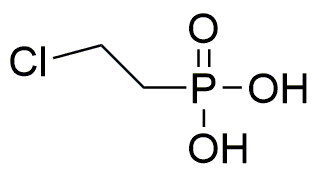(2-Chloroethyl)phosphonic acid is widely utilized in research focused on:
- Agriculture: This compound serves as a plant growth regulator, promoting root development and enhancing crop yields. It is particularly effective in stimulating the growth of fruits and vegetables, making it valuable for farmers seeking to improve their harvests.
- Herbicide Development: It is used in the formulation of herbicides, helping to control unwanted vegetation. Its efficacy in targeting specific plant species makes it a preferred choice for developing selective herbicides.
- Pharmaceuticals: In medicinal chemistry, this compound is explored for its potential in developing new drugs, particularly in the treatment of various diseases. Its unique chemical properties allow for the synthesis of novel therapeutic agents.
- Research Applications: It is commonly utilized in laboratory settings for studying biochemical pathways and cellular responses. Researchers leverage its properties to investigate phosphonic acid derivatives and their biological effects.
- Industrial Processes: This chemical is also employed in various industrial applications, including the production of flame retardants and plasticizers, contributing to enhanced material performance and safety.
General Information
Properties
Safety and Regulations
Applications
(2-Chloroethyl)phosphonic acid is widely utilized in research focused on:
- Agriculture: This compound serves as a plant growth regulator, promoting root development and enhancing crop yields. It is particularly effective in stimulating the growth of fruits and vegetables, making it valuable for farmers seeking to improve their harvests.
- Herbicide Development: It is used in the formulation of herbicides, helping to control unwanted vegetation. Its efficacy in targeting specific plant species makes it a preferred choice for developing selective herbicides.
- Pharmaceuticals: In medicinal chemistry, this compound is explored for its potential in developing new drugs, particularly in the treatment of various diseases. Its unique chemical properties allow for the synthesis of novel therapeutic agents.
- Research Applications: It is commonly utilized in laboratory settings for studying biochemical pathways and cellular responses. Researchers leverage its properties to investigate phosphonic acid derivatives and their biological effects.
- Industrial Processes: This chemical is also employed in various industrial applications, including the production of flame retardants and plasticizers, contributing to enhanced material performance and safety.
Documents
Safety Data Sheets (SDS)
The SDS provides comprehensive safety information on handling, storage, and disposal of the product.
Product Specification (PS)
The PS provides a comprehensive breakdown of the product’s properties, including chemical composition, physical state, purity, and storage requirements. It also details acceptable quality ranges and the product's intended applications.
Certificates of Analysis (COA)
Search for Certificates of Analysis (COA) by entering the products Lot Number. Lot and Batch Numbers can be found on a product’s label following the words ‘Lot’ or ‘Batch’.
*Catalog Number
*Lot Number
Certificates Of Origin (COO)
This COO confirms the country where the product was manufactured, and also details the materials and components used in it and whether it is derived from natural, synthetic, or other specific sources. This certificate may be required for customs, trade, and regulatory compliance.
*Catalog Number
*Lot Number
Safety Data Sheets (SDS)
The SDS provides comprehensive safety information on handling, storage, and disposal of the product.
DownloadProduct Specification (PS)
The PS provides a comprehensive breakdown of the product’s properties, including chemical composition, physical state, purity, and storage requirements. It also details acceptable quality ranges and the product's intended applications.
DownloadCertificates of Analysis (COA)
Search for Certificates of Analysis (COA) by entering the products Lot Number. Lot and Batch Numbers can be found on a product’s label following the words ‘Lot’ or ‘Batch’.
*Catalog Number
*Lot Number
Certificates Of Origin (COO)
This COO confirms the country where the product was manufactured, and also details the materials and components used in it and whether it is derived from natural, synthetic, or other specific sources. This certificate may be required for customs, trade, and regulatory compliance.


